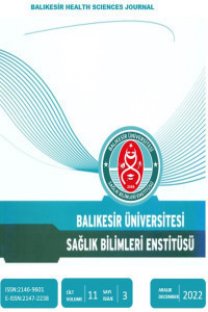Öğrenci Hemşirelerin Meslek Algıları ve Akademik Motivasyonlarının “Y Kuşağı” Özelliklerine Göre İncelenmesi
Examination of The Profession Perceptions and Academic Motivations of Nursing Students According to The Characteristics of Y Generation
___
- Andersson, E. P. (1993). The perspective of student nurses and their perceptions of professional nursing during the nurse training programme. Journal of Advanced Nursing, 18(5), 808–815.
- Anselmo-Witzel, S., Orshan, S. A., Heitner, K. L., & Bachand, J. (2017). Are generation y nurses satisfied on the job? Understanding their lived experiences. Journal of Nursing Administration, 47(4), 232–237. https://doi.org/10.1097/NNA.0000000000000470
- Barron, K. E., & Harackiewicz, J. M. (2001). Achievement goals and optimal motivation: Testing multiple goal models. Journal of Personality and Social Psychology, 80(5), 706–722. https://doi.org/10.1037/0022-3514.80.5.706
- Bhana, V. M. (2014). Interpersonal skills development in generation y student nurses: A literature review. Nurse Education Today, 34(12), 1430–1434. https://doi.org/10.1016/j.nedt.2014.05.002
- Cubit, K. A., & Ryan, B. (2011). Tailoring a Graduate Nurse Program to meet the needs of our next generation nurses. Nurse Education Today, 31(1), 65–71. https://doi.org/10.1016/j.nedt.2010.03.017
- Dağhan, Ş., Erkin, Ö., & Bayık Temel, A. (2016). Üniversite öğrencilerinin ideal kariyer olarak hemşirelik mesleğini algılamaları. Ege Üniversitesi Hemşirelik Fakültesi Dergisi, 32(1), 59–71.
- Demirkaya, H., Akdemir, A., Karaman, E., & Atan, Ö. (2015). Kuşakların yönetim politikası beklentilerinin araştırılması. İşletme Araştırmaları Dergisi, 7(1), 186–204.
- Elliot, A. J., & Thrash, T. M. (2001). Achievement goals and the hierarchical model of achievement motivation. Educational Psychology Review, 13(2), 139–156. https://doi.org/10.1023/A:1009057102306
- Emeghebo, L.(2012). The image of nursing as perceived by nurses. Nurse Education Today, 32(6), 49–53. https://doi.org/10.1016/j.nedt.2011.10.015
- Göktaş, P.(2016). Y kuşağının iletişim sorunlarının analizi ve çözüm önerileri: Süleyman Demirel Üniversitesi, Isparta Meslek Yüksek Okulu örneği. Karadeniz Teknik Üniversitesi İletişim Fakültesi Elektronik Dergisi, 11, 35–37.
- Karagüven, M. H. (2012). Akademik Motivasyon Ölçeği’nin Türkçeye adaptasyonu. Kuram ve Uygulamada Eğitim Bilimleri, 12(4), 2599–2620.
- Koç, S., Bardak, A., & Yılmaz, K., (2014). Hemşirelik son sınıf öğrencilerinin iş yerinden beklentilerinin belirlenmesi. Koç Üniversitesi Hemşirelikte Eğitim ve Araştırma Dergisi (HEAD), 11(3), 43– 50.
- Kuru, İ (2014). Y kuşağı iş ve yaşam dengesi. [Yayınlanmamış yüksek lisans tezi]. Bahçeşehir Üniversitesi.
- Matuga, J. M. (2009). Self-regulation, goal orientation, and academic achievement of secondary students in online university courses. Educational Technology & Society, 12(3), 4–11.
- May, F. E., Champion, V., & Austin, J. K. (1991). Public values and beliefs toward nursing as a career. The Journal of Nursing Education, 30(7), 303–310.
- McCaslin, M., & Hickey, D. T. (2001). Self-regulated learning and academic achievement: A Vygotskian view. Içinde B J Zimmerman & D. H. Schunk (Ed.), Self-Regulated Learning and Academic Achievement: Theoretical perspectives (ss. 227–252).
- Sarıtaş, S. Ç., Derin, N., & Sarıtaş, S. (2014). Hemşirelik öğrencilerinde mesleki imaj algısının meslekte kalma niyeti üzerine etkisi. İnönü Üniversitesi Sağlık Bilimleri Dergisi, 3(1), 29–32.
- Sherman, R. O. (2015). Recruiting and Retaining Generation Y Perioperative Nurses. AORN Journal, 101(1), 138–143. https://doi.org/10.1016/j.aorn.2014.10.006
- Türk Dil Kurumu. (2018). Türk Dil Kurumu Sözlükleri. Erişim tarihi 03.05.2018, http://www.tdk.gov.tr/index.php?option=com_bts &view=bts
- Ünsar, S., Akgün Kostak, M., Kurt, S., & Erol, Ö. (2011). Hemşirelerin kendini gerçekleştirme düzeyleri ve etkileyen etmenler. Dokuz Eylül Üniversitesi Hemşirelik Yüksekokulu Elektronik Dergisi, 4(1), 2–6.
- Vallerand, R. J., Pelletier, L. G., Blais, M. R., Briere, N. M., & Senecal, C., & Vallieres, E. F. (1993). On the assessment of intrinsic, extrinsic, and amotivation in education: evidence on the concurrent and construct validity of the Academic Motivation Scale. Educational and Psychological Measurement, 53(1), 159–172. https://doi.org/10.1177/0013164493053001018
- Walker, K. (2007). Fast-track for fast times: catching and keeping generation y in the nursing workforce. Contemporary Nurse, 24, 147–158. https://doi.org/10.5172/conu.2007.24.2.147
- Winne, P. H. (2001). Self-regulated learning viewed from models of information processing. Içinde B J Zimmerman & D. H. Schunk (Ed.), Self-regulated learning and academic achievement: Theoretical perspectives (ss. 153–189). Mahwah, NJ, US: Lawrence Erlbaum Associates Publishers.
- Yüksekbilgili, Z. (2013). Türk tipi y kuşağı. Elektronik Sosyal Bilimler Dergisi, 45, 342–353. https://doi.org/10.17755/esosder.93321
- Zimmerman, B. J. (1990). Self-regulated learning and academic achievement: an overview. Educational Psychologist, 25(1), 3–17. https://doi.org/10.1207/s15326985ep2501_2
- ISSN: 2146-9601
- Yayın Aralığı: Yılda 3 Sayı
- Yayıncı: BALIKESİR ÜNİVERSİTESİ
Üniversitesi Öğrencilerinde Tıkınırcasına Yeme Bozukluğu
Ayşegül BAYRAMOĞLU, Kübra TURNA, Necmiye Ezgi HOROZ
Edibe PİRİNÇCİ, Enis ÖZKAN, İbrahim Halil AKKUŞ, Osman KURT, Ufuk ACAR, A. Ferdane OĞUZÖNCÜL, Süleyman Erhan DEVECİ
Erken Gebelikte Diyabet, Sıçanların Endometrial Bezlerinin Karbonhidrat Salgılarını Etkiler mi?
Balıkesir İl Merkezindeki Gebe Kadınların Prenatal Bakım Alma Durumu ve Etkileyen Faktörler
Çocuklarda Tırnak Yeme Davranışı: Onikofaji
Cerrahi Kliniklerde Yatan Hastaların Psikolojik Yardım Arama Tutumu
Melike ERTEM, Sevdagül KARAGÖZ
Yenidoğanlarda Ağrı Yönetiminde Kullanılan Kanıt Temelli Nonfarmakolojik Hemşirelik Uygulamaları
Duygu KEMER, Ayşegül İŞLER DALGIÇ
Bilişsel Çarpıtma Düzeyi ile Depresyon ve Anksiyete Düzeyi Arasındaki İlişki: Sistematik Derleme
Çiğdem YÜKSEL, Neşe MERCAN, Melisa BULUT
Sağlıklı Yaşam Biçimi Davranışları Kapsamında Özel Gereksinimi Bulunan Çocukların Ebeveynleri
